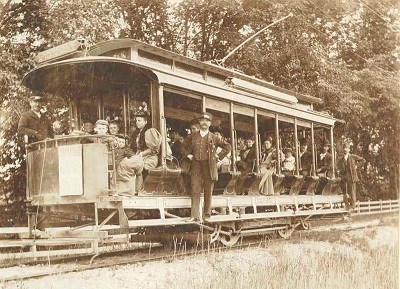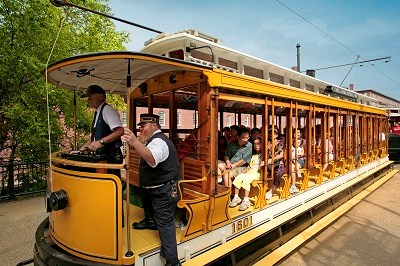
Early City TransportLike other urban areas in early 19th-century America, Lowell was a “walking city.” Residents used their feet for all inner-city travel. Beginning in the 1840s, omnibuses appeared in larger cities such as Boston, New York, and Philadelphia, but Lowell remained a walking city. Rapid growth in the decades before the Civil War, however, prompted Lowell’s landowners and real estate speculators to build houses in new neighborhoods away from the downtown. While many working-class residents remained in or near the congested city center, which contained factories and boardinghouses, the burgeoning middle class and wealthier citizens settled in outlying neighborhoods. To link the city center with Lowell’s growing neighborhoods, the Lowell Horse Railroad Company established the city’s first horse-powered streetcar. Completed in 1864, the company’s line extended from Belvidere, on the east side of Lowell, into the downtown, then westward to Pawtucket Falls. This venture proved quite profitable. The continued growth of Lowell and its environs in the decades following the Civil War fostered the development of Lowell’s early suburbs. Real estate boomed in Lowell and in other American cities, aided by a proliferation of streetcar lines. By the late 1880s, many transport companies began investing in the latest technology, the electric streetcar. The Trolleys of Lowell
At the turn of the century, Lowell’s downtown bustled with activity. Horses, wagons, and pedestrians shared city streets with electrically powered trolleys. A maze of overhead wires extended above the steel rails of the trolley tracks that were built in the middle of stone-paved streets. In the downtown, trolleys stopped at each block, discharging scores of passengers while others clambered aboard. Workers and managers, shopkeepers and clerks, children and the elderly all mingled on the trolleys. Despite resistance from their employers, Lowell's streetcar workers pushed for higher wages and better working conditions. In 1903 they joined with Amalgamated Association of Streetcar Employees to form a trade union. The streetcar workforce and the union were composed entirely of men, many of whom were Irish. 
Accompanying the growth of inner-city trolley lines were interurban street railways that ran from city to city. Many transport companies, however, lacked sufficient capital to operate and maintain their lines. Large firms frequently absorbed smaller companies, discontinuing service to some areas, while expanding it in others. To maintain profits, streetcar managers cut labor as well as operating costs. Strikes by trolley workers, as well as public dissatisfaction with streetcar companies, intensified in the early 1900s. Reflecting the “merger-mania” in the transport industry, Lowell’s streetcar lines were acquired in 1901 by the Lynn & Boston Railroad Company, which was reorganized as the Boston & Northern Street Railway Company. This firm, headed by Patrick F. Sullivan of Lowell, was the largest transport company north of Boston. A second and even larger merger under the aegis of the Bay State Railway Company failed to improve the region’s streetcar system. The Bay State firm declared bankruptcy in 1918. The decade of the 1920s marked the decline of New England’s street railways. The growing popularity of automobiles and buses cut into streetcar business. Ridership continued to drop. Additional mergers and reorganizations generally worsened conditions for riders and streetcar workers alike. By 1935 electric trolleys made their last run in Lowell--that is, until 1984. The Trolleys of Lowell National Historical Park
Jim Higgins The GOMACO Corporation of Ida Grove, Iowa, built the park’s small fleet of trolleys. Because the old trolley tracks were torn up from Lowell’s streets during World War II, the park’s trolleys run on tracks of the former Boston and Maine Railroad. An overhead 600-volt line of direct current powers the cars. Each of the park’s two open-air cars seats 90 people; the enclosed trolley seats 48. |
Last updated: November 3, 2018
